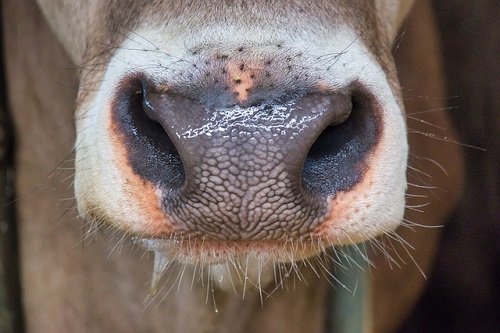Introduction
Ruminants have a uniquely designed digestive system to ferment feedstuffs and provide energy precursors for the animal to use. Ruminant animals such as cattle efficiently use high roughage feedstuffs, including forages.
Ruminants eat rapidly, swallowing much of their feedstuffs without chewing it sufficiently. The esophagus functions bi-directionally in ruminants, allowing them to regurgitate their cud for further chewing, if necessary. The process of rumination or “chewing the cud” is where forage and other feedstuffs are forced back to the mouth for further chewing and mixing with saliva. Saliva aids in chewing and swallowing. This cud is then swallowed again and passed into the reticulum. Then the solid portion slowly moves into the rumen for fermentation, while most of the liquid portion rapidly moves from the reticulo-rumen into the omasum and then abomasum. The solid portion left behind in the rumen typically remains for up to 48 hours and forms a dense mat in the rumen, where microbes can use the fibrous feedstuffs to make precursors for energy.

Ruminants produce prodigious quantities of saliva. Published estimates for adult cows saliva secretion are in the range of 100 to 150 liters per day. Apart from its normal lubricating qualities, saliva serves at least two very important functions in the ruminant:
- Provision of fluid for the fermentation vat
- Alkaline buffering – saliva is rich in bicarbonate, which buffers the large quantity of acid produced in the rumen and is probably critical for maintenance of rumen pH.
Important points about saliva
- Saliva is produced and secreted from exocrine salivary glands in the mouth.
- The secretory elements of salivary glands are groups of cells called acini.
- The fluid goes through small collecting ducts within salivary glands which then filter into larger ducts, then forming a single large duct that empties into the oral cavity as saliva.
- Acini cells secrete a fluid that contains water, electrolytes and mucous.
- Saliva is added during the mastication of feed, 110-180 litres of saliva are needed per day for chewing, regurgitation and rumination. This amount of saliva is variable, depending on the amount and components of feed given.
- Saliva acts as a buffer for rumination and cud formation.
- The salivary buffer also acts as a rumen pH stabilizer.
In the ruminant, as in other animals, saliva not only aids in the swallowing of feed but also undoubtedly plays an important role in feed intake and utilization. Saliva is a buffering agent and a nitrogen source for the microbial population, in the rumen. Saliva contains enzymes for breakdown of fat (salivary lipase) and starch (salivary amylase), and is involved in nitrogen recycling to the rumen. Saliva’s most important function is to buffer pH levels in the reticulum and rumen.
Functions of saliva
- Lubrication and taste: Saliva facilitates mastication (chewing) and swallowing of the bolus. It also aids in the regurgitation of the cud for further chewing and mixing with saliva.
- Enzymatic activity: Saliva contains lipases (enzymes that break down fat) that preferentially hydrolyze short-chain fatty acids from triglycerides as well as amylase, which begins the breakdown of starch.
- Source of nutrients for ruminal microorganisms: Muco-protein and urea serve as nitrogen sources and are involved in nitrogen recycling. Electrolytes in saliva, particularly sodium, are growth factors for ruminal bacteria. Keeping the rumen microbes healthy and functioning will contribute to healthier, more efficient calves.
- Influence nutrient removal rate from the rumen: Saliva is an important contributor to the fluidity of ruminal contents. This encourages animal to keep eating as the rate of passage out of the rumen increases and for nutrient absorption into the bloodstream to be accomplished at a faster rate.
- Buffering capacity: This is a major function of saliva as bicarbonate and phosphate buffers the pH levels in the reticulum and rumen. Bicarbonate is a buffering agent not produced in the rumen and naturally found in saliva. Sodium bicarbonate may be added to diets or supplements to prevent a drastic drop in ruminal pH. Phosphates of the saliva neutralize acids produced in the rumen and help to maintain a pH above acidotic levels.
- Antifoaming agent: Mucin, found in saliva, is an effective anti-foaming agent and plays a role in preventing bloat. An increase in saliva results in greater mucin production and decreases the risk of bloat.






Original reprint if the article titled “Influence of saliva on digestion in ruminants” is needed please.
I m a dairy farmer in Pakistan,Punjab. Pl let me know about the advantages and disadvantages of silage of super napier grass.
Regards
Cattle do not secrete salivary amylase.
Kay, R. N. B. The influence of saliva on digestion in ruminants. World Rev. Nutr. Diet. 1966, 6, 292-325